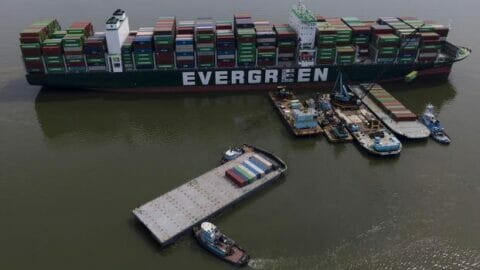
The U.S. Coast Guard on Friday brought in a much larger floating crane to remove the Alert, one of two vessels that sank near the Interstate 5 Bridge. The former World War II submarine chaser should be lifted and moved to the shipyard within three days.
While the process of lifting and moving the Alert and the sunken towboat Sakarissa is complex and expensive, nearly $3.25 million, there’s a plan for Oregon’s government to have a much better way to prevent boats from becoming derelict.
The Oregon legislature will consider the new plans in the next session, which might lead to also removing the roughly 250 other abandoned derelict boats in the Columbia and Willamette rivers.
“I’m so grateful we got to a solution here,” said Capt. Scott Jackson, commander of Coast Guard Sector Columbia River.
Removal
Beginning at about 7 a.m. Saturday, the D.B. Pacific Lifter ship, the largest crane barge on the West Coast, will begin lifting the Alert, which sunk in November. Diving crews already threaded chains underneath the hull of the vessel, and the crane will lift the ship up slowly while crews observe to see if the hull is holding together.
If the ship doesn’t start collapsing and tearing open, it will be either patched up so it can float, or it will be placed on a floating dry dock and taken to Diversified Marine where any oily water left in the ship will be removed. The Pacific Lifter ship is contracted to work on the site for three days.
The Oregon Department of State Lands will then retake control of the two ships and scrap them.
If the Alert starts tearing open during lifting this weekend, the Coast Guard will stop and reassess its options. One possibility is to remove as much contaminated water and trash in the boats and then cut the ship open while it’s still in the water. The Coast Guard had to do that recently with another sunken ship in Astoria called Tourist No. 2.
The Sakarissa was lifted by a smaller floating crane barge and removed by the Coast Guard earlier this week. It is now at Diversified Marine being cleaned of contaminants.
Watery conundrum
The historic Sakarissa and Alert ships were planned to be restored and turned into museum exhibits by Harvey Walter James, but he could not raise enough money for the fix-ups. James died sometime in the last few years, but details about the former owner are sparse.
Both ships had homeless people living on and in them. The Coast Guard saw evidence that someone had cut holes in the pipes and the hull, causing both ships to sink within the past year.
The Oregon Department of State Lands, which owns the land underneath the sunken ships, officially seized control of both boats after they sunk. The agency was aware of the boats and the homeless people living on them, but there isn’t a state program to coordinate the removal of abandoned ships until they’ve sunk and caused a greater issue, said Bill Ryan, Deputy Director for Operations at The Oregon Department of State Lands.
Ryan said that local law enforcement was reluctant to remove the homeless people living on the ships, further delaying the removal.
Once the ships sunk, the removal process became easier for both the Oregon Department of State Lands and the U.S. Coast Guard, said Ryan.
That might change with a new push to have a system to better prevent and also remove the other derelict boats in Oregon, mostly in the Columbia and Willamette Rivers.
Ryan said he wants Oregon to replicate some of Washington’s vessel oversight programs. He wants Oregon to have the ability to better register boats, enforce insurance requirements for boats and track who owns them. Washington has a law that the seller and buyer of a boat must have insurance.
A draft of a bill is being analyzed by the Oregon State Governor’s office now, he said.
“If people have an old boat, and they want to get rid of it, they can sell it to someone for a dollar,” he said. “If you’re driving your car down the street and you leave it on the side of the street, it would take police a short time to know whose it is.”
A rough estimate to remove all the 350 or so abandon or derelict vessels in Oregon could cost $40 million, Ryan said.
The Oregon Department of State Lands is next month going to consider ending overnight camping on the stretch of Hayden Island beach near the sunken ships where there has been an increase in homeless camping. There are still signs of campfires and encampments near the sunken ships.
Show Full Article
© Copyright 2022 The Columbian, Vancouver, Wash.. All rights reserved. This material may not be published, broadcast, rewritten or redistributed.
Tags: Coast Coast Guard Coast Guard News Columbia Guard Military Remove River Ship Sunken Working Warriors works








